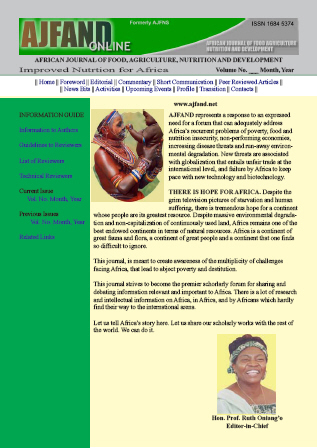
|
African Journal of Food, Agriculture, Nutrition and Development
Rural Outreach Program
ISSN: 1684-5358
EISSN: 1684-5358
Vol. 18, No. 2, 2018, pp. 13451-13469
|
 Bioline Code: nd18043
Bioline Code: nd18043
Full paper language: English
Document type: Research Article
Document available free of charge
|
|
|
African Journal of Food, Agriculture, Nutrition and Development, Vol. 18, No. 2, 2018, pp. 13451-13469
| en |
FIELD MEASUREMENTS AND STATISTICAL ANALYSIS OF PERFORATED GRATING SURFACES FOR GRATING FRESH CASSAVA INTO MASH IN GHANA
Obeng, GY; Opandoh, D & Mensah, E
Abstract
Processing of cassava into mash requires grating of fresh cassava tubers through the
abrasive action of the grating surfaces of cassava graters that grind against the cassava
and transforms it into mash. Over the years, improved cassava graters have been designed
and made available on the market. In spite of improvements in design, there are no
standards for the manufacture of grating surfaces and this affects interchangeability of
the product. Mechanised grating of fresh cassava into mash contributes to reduce postharvest
losses of cassava, increase its shelf life and improve food security. However,
majority of the cassava grating surfaces are poorly made with substandard measurements
that affect the desired particle size of mash for gari, a staple food for millions of people
in West Africa. This study assessed cassava grating surfaces focusing on the abrasive
elements (tooth diameter and inter-tooth spacing). Qualitative data were gathered from
local metal fabricators and female gari processors in separate focus group discussions.
The purpose was to gather the narratives underlying the issues being studied so as to
complement and enrich the quantitative data. 112 tooth diameters and 112 inter-tooth
spacing of perforated cassava grating surfaces were randomly measured in 16 different
study areas in 3 regions of Ghana, namely Western, Central and Ashanti. Results from
the qualitative data showed that grating of cassava was done repeatedly (about 2-3 times)
before reaching the desired particle size of mash for gari. Most customers desire grating
surfaces that ensure effective contact between the cassava and the metal grating surface
to reduce grating time. Results from the field measurements showed high variation in
existing tooth diameters (min=1.80, max=4.50 mm) and inter-tooth spacings (min=3.50,
max=12.00 mm) that resulted in non-uniform particle size of cassava mash. Using
statistical analysis, tooth diameters (min=3.18, max=3.42mm) and inter-tooth spacings
(min=7.12, max=7.78mm) were determined at 95% confidence interval. For practical
purposes, tooth diameter of 3 mm and inter-tooth spacing of 8 mm are recommended.
The availability of such data will contribute significantly to standardise perforated
cassava grating surfaces to achieve product interchangeability and desired quality of
grated mash for gari. This will contribute to improve the manufacture of cassava graters
and sustainable gari processing business in Ghana and Africa.
Keywords
Fresh cassava; cassava grating surface; gari; food quality; Ghana
|
| |
© Copyright 2018 - African Journal of Food, Agriculture, Nutrition and Development
Alternative site location: http://www.ajfand.net/
|
|
